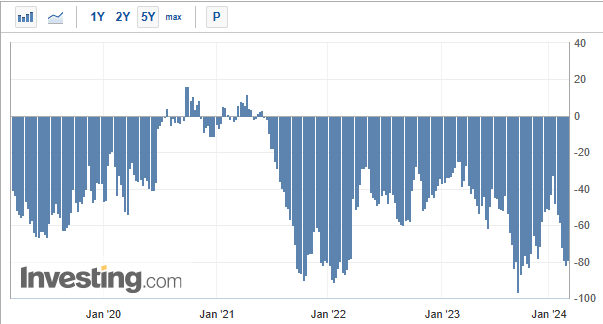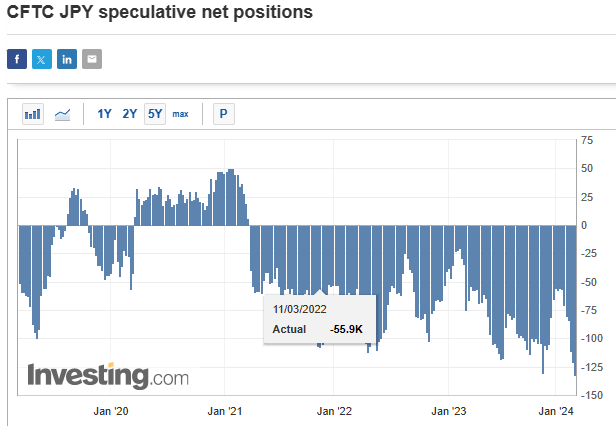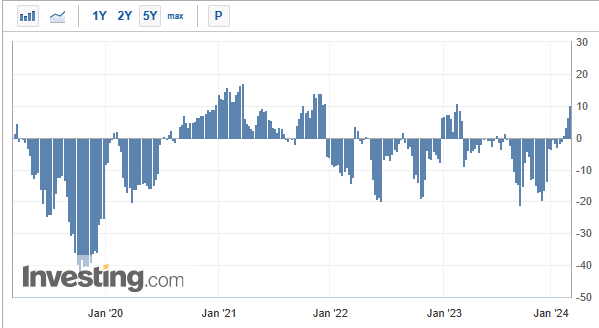
Summary of key points: -
- Statistics, statistics and blasted lies! – US jobs and inflation data
- Fed confirmation of interest rate cuts sends the US dollar lower
- FX market speculative positioning in for some abrupt changes
Statistics, statistics and blasted lies! – US jobs and inflation data
The value of the US dollar has depreciated 2.00% over the past month from 104.70 on the USD Dixy Index in mid- February to 102.70 at the close on Friday 9th March. As a result, the NZD/USD exchange rate has been able to claw back its RBNZ-induced losses of the previous week and climb one cent higher to 0.6180.
The USD appreciated strongly over the first two weeks of February from below 101.00 on the Index to above 104.00 on the back of much stronger than expected US Non-Farm Payrolls employment data for December and January. The much stronger labour market data at the time prompted the financial markets to push back the timing of interest rate cuts this year from the Federal Reserve. Forward pricing in the interest rate markets shifted from the first cut being in March to May and June. The reason why the US dollar has not been able to sustain its gains and has weakened back over the last three weeks is softer than expected economic data, culminating in massive downward revisions in the previously sky-high December and January jobs numbers. Non-Farm Payrolls data for the month of February released Friday 9th March revised down the December 323,000 increase to +290,000 and the January 353,000 increase to +229,000! The outrageous historical revisions do put into question the data collection methodology and accuracy by the US Bureau of Labour Statistics. Financial and investment markets react to the headline numbers when they are first released, and it causes unnecessary market volatility when the figures released are just wrong and not reflective of what is really going on in the US economy. We highlighted at the time the fact that the January jobs numbers were dodgy and should not be relied upon. In other words, the US dollar strength in early February was based on false economic data.
The 275,000 increase in jobs in February released last Friday was higher than the prior consensus forecasts of +200,000. However, the outsized downward revisions to December and January figures, plus the fact that the unemployment rate jumped up to 3.90% from the previous 3.70% was sufficient to drive US interest rate yields lower and the USD lower. In addition, average hourly earnings wages data was less than forecast at a 0.10% increase for February.
It is not just the US labour market statistics that are unreliable, how the house rental prices (Shelter CPI) are calculated for the official monthly CPI inflation releases is also seriously flawed. The rental data is already lagged by 12 month and not accurately reflecting current housing costs in the US economy. Deep dive analysis into the weeds of the data has revealed that the 0.50% increase in the “OER” component of Shelter CPI (Owner Occupied Rents, where homeowners estimate by survey what rent they would receive if they rented their house out) in January was caused by a sudden adjustment to the weightings of different types of houses and not actually an increase in the dollar rental amount. The skew appeared to come from single-family detached units which were re-benchmarked to a 50% weighing from the low 40’s last year and 35% the year before. The 0.50% rent/shelter increase in January contributed 60% of the overall 0.30% increase in inflation for that month. Stripping out the out-of-date rental data from the CPI figures would have annual US inflation running well below 2.00% currently. It will be interesting to see the impact of rents/shelter on the February CPI figures when they are released this Tuesday 12th March. Consensus forecasts are for another 0.30% increase, marginally reducing the annual rate of inflation from 3.20% to 3.10%. The Fed preferred PCE measure of inflation is already running at a 2.40% annual increase.
Fed confirmation of interest rate cuts sends the US dollar lower
It could be that Federal Reserve Chair, Jerome Powell is well aware of the distorted jobs and inflation statistics and that is why he confirmed to the Congress politicians last week that they are “not far away” from the point of cutting interest rates. That emphatic confirmation appeared to come as a surprise to the FX market US dollar “bulls” (those expecting continuing USD appreciation), who somehow believed that Chair Powell was going to state that interest rates could not be cut this year. That was never going to be the case, and the USD was sold as the USD bulls were disappointed and reversed their market positions. The interest rate markets are now pricing in four times 0.25% cuts this year, commencing in June. If the evolving US economic data continues to be weaker than forecast, that pricing will change to earlier and larger cuts. The US dollar value will consequently weaken.
Forward looking US ISM survey of manufacturing PMI data released last week confirmed that activity levels this year in the US economy and certainly softer than in 2023. Manufacturing new orders came in at 49.2 against a prior forecast of 52.6. ISM Services sector survey on pricing intentions was also significantly below expectations, printing at 58.6 against prior forecast of 63.0. The consistent theme with all this US economic data is that the economic forecasters are overly optimistic and are not reading the softer underbelly to demand in the economy in early 2024 after 18 months of tight monetary policy.
The likelihood of a higher NZ dollar value against the USD over coming months received a boost from an unlikely source last week. RBNZ Chief Economist, Paul Conway, in a speech, recognised that things had now changed with the RBNZ holding interest rates steady for the next 12 months, whereas the US Fed will be cutting their interest rates within the next few months. That increasing interest rate differential would likely lift the NZD value and bring NZ tradable inflation down. Hallelujah! – we have been highlighting that eventuality for months.
The US Fed next meets on 20 March, wherein they should express an increasing confidence level that inflation is nearly at their target of 2.00% and there appears to be reduced risk of something coming along and pushing it back up again. Whether they actually cut rates at the May 1st meeting or June 12th meeting remains to be seen. Either way, it is going to happen and that confirms continuing USD depreciation as the Feds cuts well ahead of all other central banks.
FX market speculative positioning in for some abrupt changes
US interest rates have been well above Australian and Japanese interest rates for a number of years. Currency speculators take advantage of this “free carry” as they receive the forward points when they short sell the AUD and JPY against the USD. As the first two bar charts below confirm, the level of net short sold positions in both currencies remain high. Over recent months the AUD short sold futures contracts have increased to over 80,000 and JPY short sold contracts to over 125,000.
The currency punters clearly believe that the USD will continue to appreciate against the AUD and JPY. However, over the last week the direction and sentiment towards the Japanese Yen has abruptly changed. Increasing bets are being made that the Bank of Japan will reverse from their current super loose monetary policy settings with negative interest rates to a more normal positive interest rate. Inflation is on the rise in Japan and the Bank of Japan is about to do the opposite of every other central bank and increase interest rates. The USD/JPY exchange rate has already reversed from over 151.00 a week ago to 147.00 today.
As the US dollar continues to weaken against all currencies, further Yen gains towards 140 will cause all the currency speculators to unwind their short-sold JPY positions. The AUD speculative positioning will unwind in the same manner.
The third bar chart confirms that currency speculators have already reversed out of short-sold NZD positions to now be net “long” the NZD. Therefore, it has to be concluded that we are in for some significant falls in the NZD/JPY and NZD/AUD cross-rates, as the Yen and Aussie dollar have a far greater propensity to appreciate faster against the USD than the NZD (due to the unwinding of the spec positions). The NZD/JPY cross rate at 90.90 currently could shift to 85.00 rather quickly and the NZD/AUD cross-rate at 0.9325 should fall away to 0.9200 and 0.9100 again.



Daily exchange rates
Select chart tabs
*Roger J Kerr is Executive Chairman of Barrington Treasury Services NZ Limited. He has written commentaries on the NZ dollar since 1981.




We welcome your comments below. If you are not already registered, please register to comment.
Remember we welcome robust, respectful and insightful debate. We don't welcome abusive or defamatory comments and will de-register those repeatedly making such comments. Our current comment policy is here.